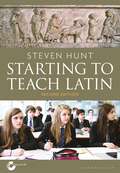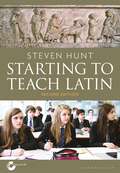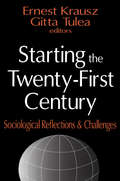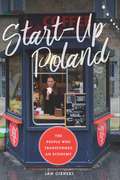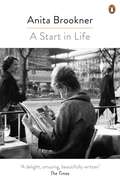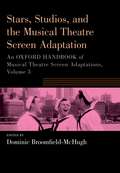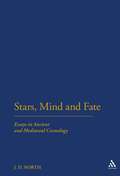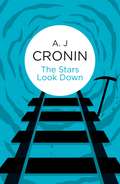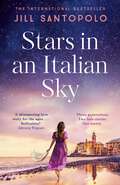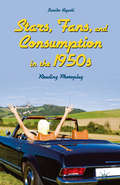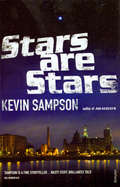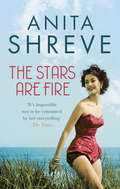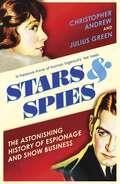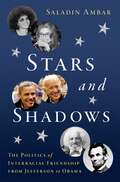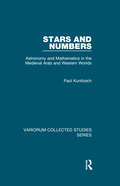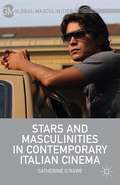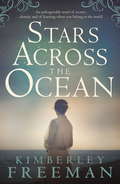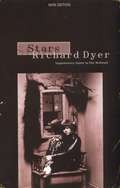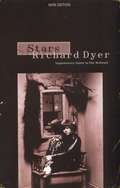- Table View
- List View
Starting to Teach Latin
by Steven HuntThis book for teachers provides both practical, up-to-date guidance and a theoretical overview on a number of key topics in Latin teaching. Updated throughout, this new edition includes information about and analysis of recent Latin textbook publications and curriculum developments across the globe. Using a wealth of interviews, observations and pupil transcripts, Steven Hunt utilizes case-study evidence of excellent practice in teaching and learning from a wide variety of institutions: from outreach programmes, community schools and academies in the UK and USA. Offering practical advice on topics such as essay writing, teaching controversial topics including women, slavery, ethnicity and social hierarchy, making use of primary sources and using ICT to advance language skills, this book also engages with broader questions of approach and theory. These include a survey of the three main approaches to Latin teaching: grammar-translation, communicative and reading approaches; explanation of cognitive and social approaches to learning; and analysis of the differences between intrinsic and extrinsic motivation. Moreover, traditional arguments about the value and purpose of learning Latin at school level are re-examined in the light of current educational thinking and government policy-making. This book is invaluable for trainees, newly qualified teachers and more experienced practitioners looking for practical ideas and strategies to motivate and engage learners of Latin.
Starting to Teach Latin
by Steven HuntThis book for teachers provides both practical, up-to-date guidance and a theoretical overview on a number of key topics in Latin teaching. Updated throughout, this new edition includes information about and analysis of recent Latin textbook publications and curriculum developments across the globe. Using a wealth of interviews, observations and pupil transcripts, Steven Hunt utilizes case-study evidence of excellent practice in teaching and learning from a wide variety of institutions: from outreach programmes, community schools and academies in the UK and USA. Offering practical advice on topics such as essay writing, teaching controversial topics including women, slavery, ethnicity and social hierarchy, making use of primary sources and using ICT to advance language skills, this book also engages with broader questions of approach and theory. These include a survey of the three main approaches to Latin teaching: grammar-translation, communicative and reading approaches; explanation of cognitive and social approaches to learning; and analysis of the differences between intrinsic and extrinsic motivation. Moreover, traditional arguments about the value and purpose of learning Latin at school level are re-examined in the light of current educational thinking and government policy-making. This book is invaluable for trainees, newly qualified teachers and more experienced practitioners looking for practical ideas and strategies to motivate and engage learners of Latin.
Starting the Twenty-first Century: Sociological Reflections and Challenges
by Ernest Krausz Gitta TuleaJrgen Habermas, speaking of postmodern society, remarked that extension of the means of communication not only allows a wide range of information, but it also encourages permanent connections between different peoples, cultures, and social discourses. It thus facilitates better general understanding, a clarifying of real or apparent contradictions. But this process becomes truly positive only when it is performed between equal members. Globalization of information does not minimize the possibility of conflict or terrorism, if fundamental social problems are not resolved or at least approached in an active way.This volume examines the major upheavals of the twentieth century and views within the framework of these events and challenges implications for the future. "Values and Cultural Changes in the Postmodern World," by Zygmunt Bauman explores the changing meaning of space in the globalizing environment; S.N. Eisenstadt analyzes the destructive components of modernity; and Irving Louis Horowitz draws attention to the classical values of the common universal culture. "Social Development and Policies in Contemporary Society," by Michael M. Cernea, examines the importance of the applied and policy-orientated research, especially in the developing countries, and David Marsland stresses the positive role of sociology in pointing to the possibilities of improving healthcare in modern society. "Societies in Transition-Eastern Europe," emphasizes transitions that have occurred in Eastern Europe. Rozalina Rjyvkina and Leonid Kosals provide an incisive study of the situation in Russia, while Jerzy J. Wiatr presents a comparative analysis of postcommunist societies, with special reference to Poland. "The Jewish World: Pre- and Post-Holocaust," by Regina Azria, discusses the identity problems in the Diaspora confronting modernity; Eva Etzioni-Halevi considers the newly developed Israeli society from the point of view of the exercise and distribution of power; and a most interesting contribution by Annette Wieviorka concerns the material and spiritual effects of the Holocaust on the Jews of France.Social historians and students of Judaica, as well as a general public interested in cultural pluralism will find this well-developed volume essential reading.
Starting the Twenty-first Century: Sociological Reflections and Challenges
by Gitta TuleaJrgen Habermas, speaking of postmodern society, remarked that extension of the means of communication not only allows a wide range of information, but it also encourages permanent connections between different peoples, cultures, and social discourses. It thus facilitates better general understanding, a clarifying of real or apparent contradictions. But this process becomes truly positive only when it is performed between equal members. Globalization of information does not minimize the possibility of conflict or terrorism, if fundamental social problems are not resolved or at least approached in an active way.This volume examines the major upheavals of the twentieth century and views within the framework of these events and challenges implications for the future. "Values and Cultural Changes in the Postmodern World," by Zygmunt Bauman explores the changing meaning of space in the globalizing environment; S.N. Eisenstadt analyzes the destructive components of modernity; and Irving Louis Horowitz draws attention to the classical values of the common universal culture. "Social Development and Policies in Contemporary Society," by Michael M. Cernea, examines the importance of the applied and policy-orientated research, especially in the developing countries, and David Marsland stresses the positive role of sociology in pointing to the possibilities of improving healthcare in modern society. "Societies in Transition-Eastern Europe," emphasizes transitions that have occurred in Eastern Europe. Rozalina Rjyvkina and Leonid Kosals provide an incisive study of the situation in Russia, while Jerzy J. Wiatr presents a comparative analysis of postcommunist societies, with special reference to Poland. "The Jewish World: Pre- and Post-Holocaust," by Regina Azria, discusses the identity problems in the Diaspora confronting modernity; Eva Etzioni-Halevi considers the newly developed Israeli society from the point of view of the exercise and distribution of power; and a most interesting contribution by Annette Wieviorka concerns the material and spiritual effects of the Holocaust on the Jews of France.Social historians and students of Judaica, as well as a general public interested in cultural pluralism will find this well-developed volume essential reading.
Start-Up Poland: The People Who Transformed an Economy
by Jan CienskiPoland in the 1980s was filled with shuttered restaurants and shops that bore such imaginative names as “bread,” “shoes,” and “milk products,” from which lines could stretch for days on the mere rumor there was something worth buying. But you’d be hard-pressed to recognize the same squares—buzzing with bars and cafés—today. In the years since the collapse of communism, Poland’s GDP has almost tripled, making it the eighth-largest economy in the European Union, with a wealth of well-educated and highly skilled workers and a buoyant private sector that competes in international markets. Many consider it one of the only European countries to have truly weathered the financial crisis. As the Warsaw bureau chief for the Financial Times, Jan Cienski spent more than a decade talking with the people who did something that had never been done before: recreating a market economy out of a socialist one. Poland had always lagged behind wealthier Western Europe, but in the 1980s the gap had grown to its widest in centuries. But the corrupt Polish version of communism also created the conditions for its eventual revitalization, bringing forth a remarkably resilient and entrepreneurial people prepared to brave red tape and limited access to capital. In the 1990s, more than a million Polish people opened their own businesses, selling everything from bicycles to leather jackets, Japanese VCRs, and romance novels. The most business-savvy turned those primitive operations into complex corporations that now have global reach. Well researched and accessibly and entertainingly written, Start-Up Poland tells the story of the opening bell in the East, painting lively portraits of the men and women who built successful businesses there, what their lives were like, and what they did to catapult their ideas to incredible success. At a time when Poland’s new right-wing government plays on past grievances and forms part of the populist and nationalist revolution sweeping the Western world, Cienski’s book also serves as a reminder that the past century has been the most successful in Poland’s history.
Start-Up Poland: The People Who Transformed an Economy
by Jan CienskiPoland in the 1980s was filled with shuttered restaurants and shops that bore such imaginative names as “bread,” “shoes,” and “milk products,” from which lines could stretch for days on the mere rumor there was something worth buying. But you’d be hard-pressed to recognize the same squares—buzzing with bars and cafés—today. In the years since the collapse of communism, Poland’s GDP has almost tripled, making it the eighth-largest economy in the European Union, with a wealth of well-educated and highly skilled workers and a buoyant private sector that competes in international markets. Many consider it one of the only European countries to have truly weathered the financial crisis. As the Warsaw bureau chief for the Financial Times, Jan Cienski spent more than a decade talking with the people who did something that had never been done before: recreating a market economy out of a socialist one. Poland had always lagged behind wealthier Western Europe, but in the 1980s the gap had grown to its widest in centuries. But the corrupt Polish version of communism also created the conditions for its eventual revitalization, bringing forth a remarkably resilient and entrepreneurial people prepared to brave red tape and limited access to capital. In the 1990s, more than a million Polish people opened their own businesses, selling everything from bicycles to leather jackets, Japanese VCRs, and romance novels. The most business-savvy turned those primitive operations into complex corporations that now have global reach. Well researched and accessibly and entertainingly written, Start-Up Poland tells the story of the opening bell in the East, painting lively portraits of the men and women who built successful businesses there, what their lives were like, and what they did to catapult their ideas to incredible success. At a time when Poland’s new right-wing government plays on past grievances and forms part of the populist and nationalist revolution sweeping the Western world, Cienski’s book also serves as a reminder that the past century has been the most successful in Poland’s history.
Start-Up Poland: The People Who Transformed an Economy
by Jan CienskiPoland in the 1980s was filled with shuttered restaurants and shops that bore such imaginative names as “bread,” “shoes,” and “milk products,” from which lines could stretch for days on the mere rumor there was something worth buying. But you’d be hard-pressed to recognize the same squares—buzzing with bars and cafés—today. In the years since the collapse of communism, Poland’s GDP has almost tripled, making it the eighth-largest economy in the European Union, with a wealth of well-educated and highly skilled workers and a buoyant private sector that competes in international markets. Many consider it one of the only European countries to have truly weathered the financial crisis. As the Warsaw bureau chief for the Financial Times, Jan Cienski spent more than a decade talking with the people who did something that had never been done before: recreating a market economy out of a socialist one. Poland had always lagged behind wealthier Western Europe, but in the 1980s the gap had grown to its widest in centuries. But the corrupt Polish version of communism also created the conditions for its eventual revitalization, bringing forth a remarkably resilient and entrepreneurial people prepared to brave red tape and limited access to capital. In the 1990s, more than a million Polish people opened their own businesses, selling everything from bicycles to leather jackets, Japanese VCRs, and romance novels. The most business-savvy turned those primitive operations into complex corporations that now have global reach. Well researched and accessibly and entertainingly written, Start-Up Poland tells the story of the opening bell in the East, painting lively portraits of the men and women who built successful businesses there, what their lives were like, and what they did to catapult their ideas to incredible success. At a time when Poland’s new right-wing government plays on past grievances and forms part of the populist and nationalist revolution sweeping the Western world, Cienski’s book also serves as a reminder that the past century has been the most successful in Poland’s history.
Start-Up Poland: The People Who Transformed an Economy
by Jan CienskiPoland in the 1980s was filled with shuttered restaurants and shops that bore such imaginative names as “bread,” “shoes,” and “milk products,” from which lines could stretch for days on the mere rumor there was something worth buying. But you’d be hard-pressed to recognize the same squares—buzzing with bars and cafés—today. In the years since the collapse of communism, Poland’s GDP has almost tripled, making it the eighth-largest economy in the European Union, with a wealth of well-educated and highly skilled workers and a buoyant private sector that competes in international markets. Many consider it one of the only European countries to have truly weathered the financial crisis. As the Warsaw bureau chief for the Financial Times, Jan Cienski spent more than a decade talking with the people who did something that had never been done before: recreating a market economy out of a socialist one. Poland had always lagged behind wealthier Western Europe, but in the 1980s the gap had grown to its widest in centuries. But the corrupt Polish version of communism also created the conditions for its eventual revitalization, bringing forth a remarkably resilient and entrepreneurial people prepared to brave red tape and limited access to capital. In the 1990s, more than a million Polish people opened their own businesses, selling everything from bicycles to leather jackets, Japanese VCRs, and romance novels. The most business-savvy turned those primitive operations into complex corporations that now have global reach. Well researched and accessibly and entertainingly written, Start-Up Poland tells the story of the opening bell in the East, painting lively portraits of the men and women who built successful businesses there, what their lives were like, and what they did to catapult their ideas to incredible success. At a time when Poland’s new right-wing government plays on past grievances and forms part of the populist and nationalist revolution sweeping the Western world, Cienski’s book also serves as a reminder that the past century has been the most successful in Poland’s history.
A Start in Life (Penguin Essentials Ser. #73)
by Anita BrooknerSince childhood, Ruth Weiss has been escaping from life into books, from the hothouse attentions of her parents into the warmth of lovers and friends. Now Dr Weiss, at 40, knows that her life has been ruined by literature and that once again she must make a new start.
Stars, Studios, and the Musical Theatre Screen Adaptation: An Oxford Handbook of Musical Theatre Screen Adaptations, Volume 3 (OXFORD HANDBOOKS SERIES)
by Dominic Broomfield-McHughHollywood's conversion to sound in the 1920s created an early peak in the film musical, following the immense success of The Jazz Singer. The opportunity to synchronize moving pictures with a soundtrack suited the musical in particular, since the heightened experience of song and dance drew attention to the novelty of the technological development. Until the near-collapse of the genre in the 1960s, the film musical enjoyed around thirty years of development, as landmarks such as The Wizard of Oz, Meet Me in St. Louis, Singin' in the Rain, and Gigi showed the exciting possibilities of putting musicals on the silver screen. The final of three volumes, Stars, Studios, and the Musical Theatre Screen Adaptation: An Oxford Handbook traces how stardom and technology has affected the evolution of the genre of the stage-to-screen musical. Many chapters examine specific screen adaptations in depth, with case studies on the screen versions of Broadway favorites Carousel and Brigadoon, while others deal with broad issues such as how music rights affected how studios approached screen adaptations. Together, the chapters incite lively debates about the process of adapting Broadway for the big screen and provide models for future studies. Volume I: The Politics of the Musical Theatre Screen Adaptation Volume II: Race, Sexuality, and Gender and the Musical Screen Adaptation Volume III: Stars, Studios, and the Musical Theatre Screen Adaptation
Stars, Studios, and the Musical Theatre Screen Adaptation: An Oxford Handbook of Musical Theatre Screen Adaptations, Volume 3 (OXFORD HANDBOOKS SERIES)
Hollywood's conversion to sound in the 1920s created an early peak in the film musical, following the immense success of The Jazz Singer. The opportunity to synchronize moving pictures with a soundtrack suited the musical in particular, since the heightened experience of song and dance drew attention to the novelty of the technological development. Until the near-collapse of the genre in the 1960s, the film musical enjoyed around thirty years of development, as landmarks such as The Wizard of Oz, Meet Me in St. Louis, Singin' in the Rain, and Gigi showed the exciting possibilities of putting musicals on the silver screen. The final of three volumes, Stars, Studios, and the Musical Theatre Screen Adaptation: An Oxford Handbook traces how stardom and technology has affected the evolution of the genre of the stage-to-screen musical. Many chapters examine specific screen adaptations in depth, with case studies on the screen versions of Broadway favorites Carousel and Brigadoon, while others deal with broad issues such as how music rights affected how studios approached screen adaptations. Together, the chapters incite lively debates about the process of adapting Broadway for the big screen and provide models for future studies. Volume I: The Politics of the Musical Theatre Screen Adaptation Volume II: Race, Sexuality, and Gender and the Musical Screen Adaptation Volume III: Stars, Studios, and the Musical Theatre Screen Adaptation
Stars, Mind & Fate: Essays in Ancient and Mediaeval Cosmology
by J. D. NorthPublished over a period of 20 years the essays collected together in this volume all relate to the lasting human preoccupation with cosmological matters and modern responses to them. The eclecticism of the typical medieval scholar might now seem astonishing, regrettable, amusing, or derisory, according to one's view of how rigid intellectual barriers should be. In Stars, Fate & Mind North argues that we will seriously misunderstand ancient and medieval thought if we are not prepared to share a willingness to look across such frontiers as those dividing astrology from ecclesiastical history, biblical chronology from astronomy, and angelic hierarchies from the planetary spheres, theology from the theory of the continuum, celestial laws from terrestrial, or the work of the clockmaker from the work of God himself, namely the universe.Surveying the work of such controversial scholars as Alexander Thom and Immanuel Velikovsky this varied volume brings together current scholarship on cosmology, and as the title suggest considers the confluence of matters of the stars, fate and the mind. The collection is accompanied by further commentary from the author and new illustrations.
The Stars Look Down
by A. J. CroninThe Stars Look Down was A.J. Cronin's fourth novel, published in 1935, and this tale of a North country mining family was a great favourite with his readers. Robert Fenwick is a miner, and so are his three sons. His wife is proud that all her four men go down the mines. But David, the youngest, is determined that somehow he will educate himself and work to ameliorate the lives of his comrades who ruin their health to dig the nation's coal. It is, perhaps, a typical tale of the era in which it was written – there were many novels about coal mining, but Cronin, a doctor turned author, had a gift for storytelling, and in his time wrote several very popular and successful novels In the magnificent narrative tradition of The Citadel, Hatter’s Castle and Cronin’s other novels, The Stars Look Down is deservedly remembered as a classic of its age.
Stars in an Italian Sky
by Jill SantopoloFrom the New York Times bestselling author of The Light We Lost comes a sweeping and achingly romantic story of the course of fate, the meaning of family and the power of love. . . Genoa, Italy, 1946. Vincenzo and Giovanna fall in love the moment they set eyes on each other. The son of a count and the daughter of a tailor, they belong to opposing worlds - but the undeniable spark between them quickly burns into a deep and passionate relationship, played out against their post-war city, and Vincenzo's family's beautiful vineyard. But when shifts in political power force them each to choose a side and commit what the other believes is a betrayal, the bright future they dreamed of together is shattered.New York, 2017. Cassandra and Luca are in love. Although neither quite fits with the other's family, Cass and Luca have always felt like a perfect match for each other. But when Luca, an artist, convinces his grandfather and Cass's grandmother to pose for a painting, past and present collide to reveal a secret that changes everything . . .***'A gorgeous, epic novel . . . Jill Santopolo writes heartbreak like no other' Emily Giffin, author of Meant to Be'A shimmering love story for the ages. Stars in an Italian Sky is about the course of fate, the meaning of family and the power of love. Bellissima!'Adriana Trigiani, author of The Good Left Undone'Woven together as intricately as the fine fabrics of the Genoese tailor shop where the star-crossed lovers meet . . . A poignant tale of love, loss, class, and fate, infused with the hopefulness of true love written in the stars'Kristin Harmel, author of The Book of Lost Names and The Winemaker's Wife'A spellbinding, deeply compassionate story centered around the fraught legacy of a pair of young lovers. Sensual, heartfelt, and incredibly moving, Santopolo's latest will bring you to tears'Fiona Davis, author of The Magnolia Palace'I was swept away by Stars in an Italian Sky, Jill Santopolo's charming novel of love, both lost and found'Lisa Scottoline, author of Loyalty'Filled with pathos, longing and romance, this book is a love letter to the human heart, and a testimony to the timelessness of true and lasting love'Allison Pataki, author of The Magnificent Lives of Marjorie Post'A warm, poignant story of enduring love and loss, spanning generations and set against the background of post WWII Italy'Rhys Bowen, author of The Tuscan Child and The Venice Sketchbook'Powerful, emotional, and steeped in beauty and romance, Stars in an Italian Sky is a breathtaking tale of star-crossed lovers that stretches across generations. A sweeping story brimming with passion'Ann Mah, author of The Lost Vintage and Jacqueline in Paris
Stars, Fans, and Consumption in the 1950s: Reading Photoplay
by Sumiko HigashiAs the leading fan magazine in the postwar era, Photoplay constructed female stars as social types who embodied a romantic and leisured California lifestyle. Addressing working- and lower-middle-class readers who were prospering in the first mass consumption society, the magazine published not only publicity stories but also beauty secrets, fashion layouts, interior design tips, recipes, advice columns, and vacation guides. Postwar femininity was constructed in terms of access to commodities in suburban houses as the site of family togetherness. As the decade progressed, however, changing social mores regarding female identity and behavior eroded the relationship between idolized stars and worshipful fans. When the magazine adopted tabloid conventions to report sex scandals like the Debbie-Eddie-Liz affair, stars were demystified and fans became scandalmongers. But the construction of female identity based on goods and performance that resulted in unstable, fragmented selves remains a legacy evident in postmodern culture today.
Stars are Stars
by Kevin SampsonFifteen-year-old Danny has just one dream: to be an artist. Living in Toxteth, with his mother and five sisters, Danny meets clever, politically aware Nicole and falls in love. But when Thatcher's government withdraws the Liverpool Art School's funding, Danny slides into apathy, robbing and drug dependency. Nicole and Danny's love affair, played out to a soundtrack of Bowie and Joy Division, is grand, romantic and doomed.Then Danny finds himself sucked into the longest, most exhilarating and frightening day of his life. Set on fire by rioters, Toxteth is ablaze. Danny, transfixed, starts to paint versions of the same picture, over and over again... Can Nicole bring him back from the edge?
The Stars are Fire
by Anita ShreveThe brilliantly gripping new novel from the New York Times best-selling author of The Pilot's Wife (an Oprah's Book Club selection).'Long before Liane Moriarty was spinning her Big Little Lies, Shreve was spicing up domestic doings..She still is, as effectively as ever, this time with a narrative literally lit from within' New York TimesHot breath on Grace's face. Claire is screaming, and Grace is on her feet. As she lifts her daughter, a wall of fire fills the window. Perhaps a quarter of a mile back, if even that. Where's Gene? Didn't he come home? 1947. Fires are racing along the coast of Maine after a summer-long drought, ravaging thousands of acres, causing unprecedented confusion and fear. Five months pregnant, Grace Holland is left alone to protect her two toddlers when her difficult and unpredictable husband Gene joins the volunteers fighting to bring the fire under control. Along with her best friend, Rosie, and Rosie's two young children, the women watch in horror as their houses go up in flames, then walk into the ocean as a last resort. They spend the night frantically trying to save their children. When dawn comes, they have miraculously survived, but their lives are forever changed: homeless, penniless, and left to face an uncertain future.As Grace awaits news of her husband's fate, she is thrust into a new world in which she must make a life on her own, beginning with absolutely nothing; she must find work, a home, a way to provide for her children. In the midst of devastating loss, Grace discovers glorious new freedoms - joys and triumphs she could never have expected her narrow life with Gene could contain - and her spirit soars. And then the unthinkable happens, and Grace's bravery is tested as never before.
Stars and Spies: The story of Intelligence Operations…
by Christopher Andrew Julius GreenA vastly entertaining and unique history of spying and showbiz, from the Elizabethan age to the Cold War and beyond. Throughout history, there has been a lively crossover between show business and espionage. While one relies on publicity and the other on secrecy both require high levels of creative thinking, improvisation, disguise and role-play. This crossover has produced some of the most extraordinary undercover agents and, occasionally, disastrous and dangerous failures. Stars and Spies is the first history of the interplay between the two worlds, written by two experts in their fields. We travel back to the golden age of theatre and intelligence in the reign of Elizabeth I and onwards into the Restoration. We visit Civil War America, Tsarist Russia and fin de siècle Paris where some writers, actors and entertainers become vital agents, while others are put under surveillance. And as the story moves through the twentieth century and beyond, showbiz provides essential cover for agents to gather information while hiding in plain sight. At the same time, spying enters mainstream popular culture, in books, film and on TV.Starring an astonishing cast including Christopher Marlowe, Aphra Behn, Voltaire, Mata Hari, Harpo Marx, Somerset Maugham, Graham Greene, Noel Coward, Alexander Korda, John le Carré and many others, Stars and Spies is a highly enjoyable examination of the fascinating links between the intelligence services and show business.
Stars and Shadows: The Politics of Interracial Friendship from Jefferson to Obama
by Saladin AmbarA sweeping look into interracial friendship's significance in American democracy from the founding to the present. The oppression of Blacks is America's original sin -- a sin that took root in 1619 and plagues the country to this day. Yet there have been instances of interracial bonding and friendship even in the worst of times. In Stars and Shadows -- a term taken from Huckleberry Finn -- Saladin Ambar analyzes two centuries of noteworthy interracial friendships that served as windows into the state of race relations in the US and, more often than not, as models for advancing the cause of racial equality. Stars and Shadows is the first work in American political history to offer a comprehensive overview of how friendship has come to shape the possibilities for democratic politics in America. Covering ten cases -- from Benjamin Banneker and Thomas Jefferson's ill-fated effort to navigate the limits imposed on democracy by slavery and white supremacy, to the more hopeful stories of James Baldwin and Marlon Brando as well as Angela Davis and Gloria Steinem -- Ambar's study illuminates how friendship is critical to understanding the potential for multiracial democracy. Political leaders and cultural figures are frequently involved in translating private feelings, relationships, and ideas, into a public ideal. Friendships and their meaning are therefore a significant part of any effort to shape public or elite opinion. The symbolism inherent in interracial friendship has always been readily apparent, down to the powerful example of Barack Obama and Joe Biden, who were not only allied politicians, but most importantly, friends. Ambar weaves a set of interlocking stories that help create a working theory of multiracial democracy that demands more of us as citizens: a commitment to engage one another and to engage our past with even greater courage and trust. Such gestures are a vital part of the story of how race and America have been shaped. Stars and Shadows helps explain America's enduring difficulty in making friends of citizens across the color line -- and why the narrative of racial friendship matters.
Stars and Shadows: The Politics of Interracial Friendship from Jefferson to Obama
by Saladin AmbarA sweeping look into interracial friendship's significance in American democracy from the founding to the present. The oppression of Blacks is America's original sin -- a sin that took root in 1619 and plagues the country to this day. Yet there have been instances of interracial bonding and friendship even in the worst of times. In Stars and Shadows -- a term taken from Huckleberry Finn -- Saladin Ambar analyzes two centuries of noteworthy interracial friendships that served as windows into the state of race relations in the US and, more often than not, as models for advancing the cause of racial equality. Stars and Shadows is the first work in American political history to offer a comprehensive overview of how friendship has come to shape the possibilities for democratic politics in America. Covering ten cases -- from Benjamin Banneker and Thomas Jefferson's ill-fated effort to navigate the limits imposed on democracy by slavery and white supremacy, to the more hopeful stories of James Baldwin and Marlon Brando as well as Angela Davis and Gloria Steinem -- Ambar's study illuminates how friendship is critical to understanding the potential for multiracial democracy. Political leaders and cultural figures are frequently involved in translating private feelings, relationships, and ideas, into a public ideal. Friendships and their meaning are therefore a significant part of any effort to shape public or elite opinion. The symbolism inherent in interracial friendship has always been readily apparent, down to the powerful example of Barack Obama and Joe Biden, who were not only allied politicians, but most importantly, friends. Ambar weaves a set of interlocking stories that help create a working theory of multiracial democracy that demands more of us as citizens: a commitment to engage one another and to engage our past with even greater courage and trust. Such gestures are a vital part of the story of how race and America have been shaped. Stars and Shadows helps explain America's enduring difficulty in making friends of citizens across the color line -- and why the narrative of racial friendship matters.
Stars and Numbers: Astronomy and Mathematics in the Medieval Arab and Western Worlds
by Paul KunitzschThe studies brought together in this second collection of articles by Paul Kunitzsch continue the lines of research evident in his previous volume (The Arabs and the Stars). The Arabic materials discussed stem mostly from the early period of the development of Arabic-Islamic astronomy up to about 1000AD, while the Latin materials belong to the first stage of Western contact with Arabic science at the end of the 10th century, and to the peak of Arabic-Latin translation activity in 12th century Spain. The first set of articles focuses upon Ptolemy in the Arabic-Latin tradition, followed by further ones on Arabic astronomy and its reception in the West; the final group looks at details of the transmission of Euclid's Elements.
Stars and Masculinities in Contemporary Italian Cinema (Global Masculinities)
by C. O'RaweStars and Masculinities in Contemporary Italian Cinema is the first book to explore contemporary male stars and cinematic constructions of masculinity in Italy. Uniting star analysis with a detailed consideration of the masculinities that are dominating current Italian cinema, the study addresses the supposed crisis of masculinity.
Stars Across the Ocean
by Kimberley Freeman1874: Only days before she is to leave the foundling home where she grew up, Agnes Resolute discovers that, as a baby, she had been abandoned with a small token of her mother: a unicorn button.Agnes always believed her mother had been too poor to keep her, but after working as a laundress in the home she recognises the button as belonging to Genevieve Breckby, the beautiful and headstrong daughter of a local noble family. Agnes had seen Genevieve once, in the local village, and had never forgotten her.Despite having no money, Agnes will risk everything in a quest that will take her from the bleak moors of northern England to the harsh streets of London, then on to Paris and Ceylon. As Agnes follows her mother's trail, she makes choices that could cost her dearly. Finally, in Australia, she tracks Genevieve down. But is Genevieve capable of being the mother Agnes hopes she will be?An enthralling story about love, motherhood and choosing who you belong to in the world by the bestselling author of LIGHTHOUSE BAY and EMBER ISLAND.Praise for Kimberley Freeman's writing:WILDFLOWER HILL'Utterly engaging.'THE COURIER-MAILLIGHTHOUSE BAY'an enchanting love story'MiNDFOODEVERGREEN FALLS'Eerie and fascinating ... the plot is brilliant in both time zones.'NEWCASTLE HERALD
Stars
by Richard Dyer Paul McDonaldThrough the intensive examination of films, magazines, advertising and critical texts, Dyer analyses the historical, ideological and aesthetic significance of stars, changing the way we understand screen icons. Paying particular attention to icons including Marlon Brando, Bette Davis, Marlene Dietrich, Marilyn Monroe and John Wayne.
Stars: Film Stars And Society (American Movies: The First Thirty Years Ser. #3)
by Richard Dyer Paul McDonaldThrough the intensive examination of films, magazines, advertising and critical texts, Dyer analyses the historical, ideological and aesthetic significance of stars, changing the way we understand screen icons. Paying particular attention to icons including Marlon Brando, Bette Davis, Marlene Dietrich, Marilyn Monroe and John Wayne.
